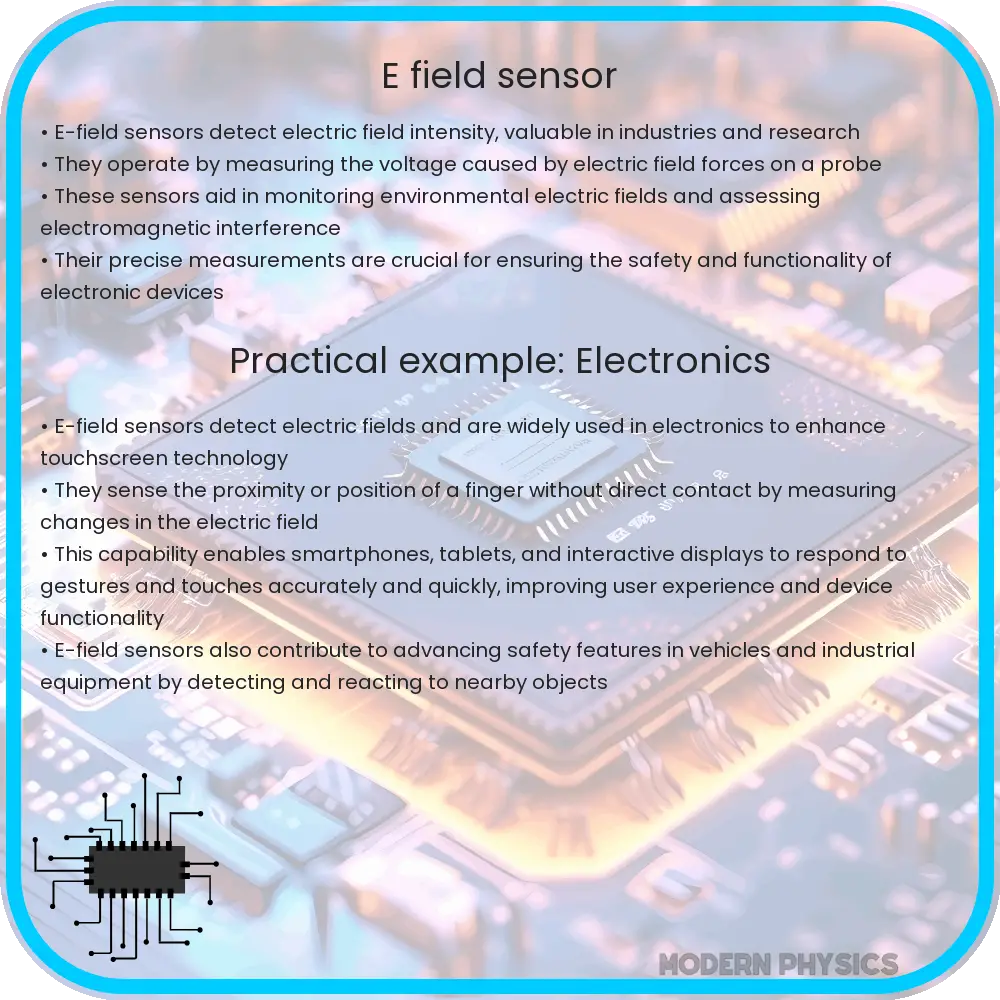Understanding E-field sensors in terms of their precision, sensitivity, and integration.

Understanding E-field Sensors: Precision, Sensitivity, and Integration
An electric field (E-field) sensor detects and measures electric field strength in its vicinity. These sensors play a vital role in numerous applications ranging from industrial process controls to environmental monitoring. To understand the importance and functionality of E-field sensors, we should delve into three critical aspects: precision, sensitivity, and integration.
Precision in E-field Sensors
Precision refers to the repeatability and reliability of the measurements provided by the sensor. In the context of E-field sensors, precision is crucial for ensuring that the measurements are consistently accurate over time and under different environmental conditions. This precision is often influenced by the design of the sensor and the quality of its components. Variability in sensor output can significantly affect practical applications, especially in sensitive environments like semiconductor manufacturing or precision material processing.
Sensitivity of E-field Sensors
Sensitivity, on the other hand, describes the sensor’s ability to detect slight changes in the electric field. A highly sensitive E-field sensor can detect weak signals that might otherwise be missed by less sensitive devices. This capability is particularly important in applications such as earthquake early warning systems, where detecting small changes in the local electric field can provide valuable seconds of warning before seismic waves arrive.
The sensitivity of an E-field sensor can generally be expressed as the minimum electric field (Emin) it can detect. This threshold depends on both the internal noise of the sensor and its response to the electric field. Reducing the noise level and enhancing the sensor’s response through advanced materials and circuit design can significantly improve sensitivity.
Integration of E-field Sensors
Finally, integration pertains to how well E-field sensors can be incorporated into larger systems and networks. For modern technological systems, especially those involved in real-time data acquisition and control, the ability to integrate sensors efficiently and effectively is indispensable. This includes physical integration into diverse environments and digital integration into data processing chains.
Effective integration often relies on the sensor’s compatibility with various communication protocols and its power requirements. Additionally, the physical size and installation ease play crucial roles in determining the feasibility of using E-field sensors in a given application area.
As industries and technologies evolve, the demand for more sophisticated E-field sensors grows. Engineers are continuously challenged to design sensors that not only meet the high standards of precision and sensitivity but are also easier to integrate into complex systems.
In the subsequent sections, we will explore the specific examples that demonstrate these principles in action, alongside the latest technological advancements that improve the precision, sensitivity, and integration of E-field sensors in various applications.
Technological Advancements in E-field Sensors
Recent technological advancements have significantly improved the capabilities of E-field sensors. Innovations in materials science, for instance, have led to the development of new sensor materials that offer higher sensitivity and lower noise. These materials enhance the sensor’s ability to detect subtle changes in the electric field, making them more reliable for critical applications.
Moreover, advancements in microfabrication techniques have enabled the production of smaller, more cost-effective sensors. These miniaturized sensors can be deployed in a wider range of applications, from wearable health monitoring devices to embedded systems in smart infrastructure. The reduction in size does not compromise their performance, maintaining high standards of precision and integrating seamlessly with other electronic components.
Real-World Applications of E-field Sensors
E-field sensors find applications in a variety of fields. In meteorology, these sensors are crucial for the detection and analysis of electrical charges in the atmosphere, helping predict storm behavior more accurately. In automotive applications, E-field sensors contribute to the development of more responsive and safer airbag deployment systems by detecting changes in the vehicle’s environment.
Another significant application area is in health and safety, where E-field sensors are used to monitor electric field variations around power lines, potentially preventing hazards related to high voltage power transmissions. Additionally, in the realm of consumer electronics, E-field sensors enable touch-sensitive interfaces, enhancing user interaction with devices.
Conclusion
The complexity and necessity of E-field sensors in modern technology cannot be overstated. Their precision impacts not only the accuracy but also the reliability of many systems across various sectors. Sensitivity allows for the detection of minute yet critical changes in the environment, adding a layer of early warning in situations like seismic activities. Moreover, the ongoing integration efforts ensure that these sensors can be part of an increasingly connected and automated world, driving innovations in sectors ranging from industrial manufacturing to personal electronics.
As technology continues to evolve, the role of E-field sensors will become even more integral, not just in specialized applications but in everyday life. The ongoing research and development aimed at improving these sensors promise to bring us safer, more efficient, and more intuitive technologies. By understanding and enhancing these fundamental properties – precision, sensitivity, and integration – engineers and scientists are set to unlock even greater potential in our interaction with the natural and technological environments.
